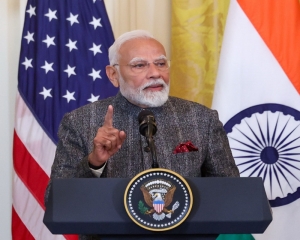Amid a mounting internal criticism, Nepal's Prime Minister KP Oli faces daunting challenges, from managing a coalition to dealing with China
My Diwali and Tihar vacation in Nepal is continuing. Here is a flash report from Pokhara. After a turbulent 18-month rule, in which former Prime Minister Prachanda had to seek a vote of confidence five times, the two leading parties Nepali Congress and Unified Marxist Leninist unholy alliance ended CPN(Maoist) kingmaker Prachanda’s rule of just 32 seats in a 205-member house. PM KP Oli-led coalition is short of a two thirds majority. They share 4 to 3 in NC’s favour in ruling the seven provinces. The promise of Ram-Rajya is unlikely to materialise. Two things stand out: an uneasy stability in government; and Oli’s apparent unpopularity . Oli’s only claim in his first 100 days is a positive stock market. And breaking the tradition of a Nepalese PM’s first overseas visit to India by going first to China from 2 to 6 December, which high profile foreign minister Arzu Rana is organising. India not inviting Oli to become PM is a deliberate omission which was served to late PM Sushil Koirala also a decade ago.
Oli’s standing as a leader has diminished because he is a junior partner to NC which is seen favoured by India, and due to his apparent loss of control and power over UML. A front-page report in Kathmandu Post (5 November) illustrates this. But alleged corruption cases against him and his supporters including the super department store chain Bhat Bhateni owner Min Bahadur Gurung have dimmed his reputation. On occasions, he was greeted with the chant “Oli chor, desh chhod”. Still, Oli retorted: “wait and watch my party perform during 2027 elections”. He is hoping to resuscitate his image from his visit to China. His stock with India is low. While Rana was given a red carpet welcome in India – meeting PM Modi, NSA Ajit Doval and Secretary to Prime Minister PK Misra – Oli’s meeting with Modi on the sidelines of UNGA was low-key. The China visit will have the Oli hallmark. He will meet President Xi Jinping, his counterpart Li Qiang and Foreign Minister Wang Yi. He will try to convert the USD 250mn loan from the Exim Bank of China for the China-constructed Pokhara International Airport – a white elephant like Hambantota in Sri Lanka – to grant though China has insisted it is part of the BRI loan. Oli is expected to sign the BRI implementation plan which China has been pressing but so far, Nepal has resisted as Kathmandu wants BRI to come under a grant scheme and not a high-interest loan. The BRI deal has been pending since 2020. Oli during his 2018 China visit had outlined 35 projects which were trimmed to nine projects under BRI. If Oli can persuade China of his ‘grant scheme for BRI’ or place some of the nine projects under it, he will have made a big breakthrough. Strangely few protest about Chinese intrusions in the north. The Jeevan Bahadur Shahi report which had recently mapped Chinese encroachments, missing border pillars and illegal construction, has been quashed.
Nepali leaders willingly oblige Beijing over the One China policy that has ensured the ‘Great Wall of China’ on the border to prevent Tibetan infiltration and migration to Dharamsala. Only one or two Tibetans slipped through this year. China wants Nepal to sign and ratify ‘the Border Management System’ which Kathmandu has not done so far. But Beijing hopes Oli will. China-Nepal relations were upgraded to Strategic Partnership during Xi’s historic 2019 visit.
The Xi visit was unique because none of the agreements signed had been implemented. A power trade agreement may be facilitated now after the completion of the 220 KVA transmission line from Rasuwagarhi to Kirung to sell power from Chinese hydro projects.It is in the energy sector that Nepal will eventually prosper. Bangladesh, Nepal and India signed a tripartite agreement for the 40MW sale of Nepal electricity to Bangladesh in the rainy season. India holds the key to the development of Nepal’s power sector. Nepal is complaining about the Bureau of Indian Standards withholding certification of exports, especially with Chinese components which will hit Kathmandu, not Beijing. The opposition is in disarray with former Home Minister, once a rising star, Rabi Lamichhane, back in jail for the Pokhara Cooperative fraud. His party and his image have taken a beating though independents like Kathmandu Mayor, Balen Shah and Dharan Mayor, Harka Sampang, are progressing relentlessly to clean politics. While King Gyanendra’s popularity may appear to be rising, a return to constitutional monarchy is unlikely despite his recent visit to Bhutan which triggered unusual speculation. It is India that is making quiet gains, the embassy keeping a low profile, letting PMO Delhi run the show. Lingering negativity about Indian interference has all but vanished. On Agniveer, the feeling among Indian Gorkha ex-servicemen is that Nepal should lift the embargo on it. “Something (even four years service) is better than nothing”. Foreign Minister S Jaishankar’s remarks in July on Agniveer (relating to Nepal) were clear. “India’s foreign policy is determined by its national interest. Not by any other country”. The message reportedly conveyed to Arzu Rana in Delhi was: “no change in terms of engagement on Agniveer” even as a review is ongoing.
COAS Gen Dwivedi is arriving here on November 21 for a ceremonial appointment as Honorary Chief of Nepal Army which has lost its lustre because not a single Nepali has been recruited in the Indian Army for five years.
(The writer, a retired Major General, was Commander, IPKF South, Sri Lanka, and founder member of the Defence Planning Staff, currently the Integrated Defence Staff; the views expressed are personal)



























